Glow-in-the-dark flowers get USDA OK
You’re always asking me “What’s new?” Well, tell me if this is new enough for you: bioluminescent petunias, meaning petunias that glow in the dark. On their own, genetically, without paint or dyes or artificial means of any sort. Other than genetic modification, that is.
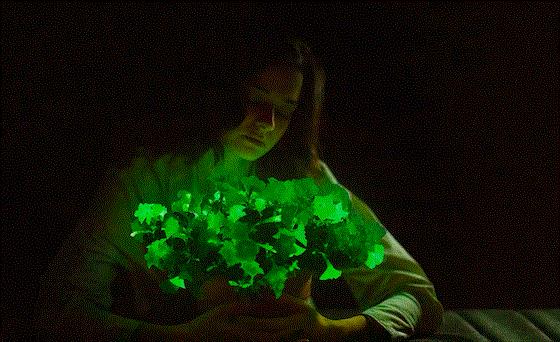
This novel introduction, which will be sold under the name “Firefly Petunias,” is coming from the synthetic biology startup Light Bio of Ketchum, Idaho. Founded in 2019, Light Bio is a “pioneering synthetic biology startup focused on cultivating vibrant bioluminescent plants … through the melding of proprietary technology and advanced genetic engineering.”
Light Bio worked in collaboration with Ginkgo Bioworks, which describes itself as “the leading horizontal platform for cell programming.”
Wild!
In a nutshell and in plain English, Firefly petunias get their glow from DNA that comes from various species of luminous mushrooms. Scientists have figured out how to genetically enhance the natural luminescence, or “glow,” of the fungal genes by many orders of magnitude. These enhanced mushroom genes, when inserted into other plants, cause those plants to glow. The luminescence is self-sustaining through a metabolic synergy with the plant. This enables perpetual illumination without any external aid—in other words, you don’t have to “charge” them with sunlight, like a watch face or something. Through testing, they’ve found that petunias provide the brightest bioluminescence, especially in the flower buds.
Hence Firefly Petunia, which will be launched in April. Light Bio is now taking orders for finished plants at www.light.bio. During the day, they look just like a regular white petunia, and require no special treatments or care. At night, they give off an “ethereal aura.” Light Bio says they’ve got 50,000 plants available for purchase on their website and can be shipped to all 48 contiguous states in the U.S. Price? Just $29 for a 4-in. pot.
You are probably asking, “Are these things legal? And safe?”
In the eyes of the United States Department of Agriculture they are. Last September, USDA determined that Light Bio’s genetically engineered Firefly Petunia may be safely grown and bred in the United States. “This creates an unparalleled opportunity for plant enthusiasts to enjoy the transformative experience of living light,” says Light Bio.
“This milestone—and the magical experience we are bringing to people across the country—has been decades in the making,” said Keith Wood, CEO of Light Bio. “As part of the scientific team that discovered the bioluminescence genes from fireflies, I helped create the first glowing plant in 1986, which has inspired scientists worldwide. In the forty-odd years since, we have discovered a new bioluminescence technology that now allows us to bring these delightful plants to consumers. We can’t wait to see their reactions and to discover the bright future ahead for this incredible technology.”
Firefly is just the beginning, they say. Working in collaboration with Ginkgo Bioworks, Light Bio anticipates that future plants will be at least 10-fold brighter. More plant varieties and more colors are also envisioned. And, they add in the press release, “in addition to the pure joy these plants bring, the underlying science also helps to elucidate the molecular physiology of plants. The teams believe that insights gained from this research will bring meaningful advancements across critical areas like food security and nutrition.”
I know what most of you think about painted poinsettias and dyed roses. I can’t wait to hear what you have to say about Firefly! Hit me with your comments HERE.

Upcoming webinars: Dissolved Oxygen, Top Perennials, Water Problems (and Solutions)
I’m gonna be a busy webinar host over the next few weeks, as our winter educational semester goes into high gear. We’ve got two excellent sessions on irrigation water, and an equally stellar session on new perennials. In fact, I'm hosting one today at 1 p.m. Eastern/Noon Central titled "Your Guide to Easy Perennial Production," If you read this soon enough to sign up (if not, don't worry, it's archived under the "Available Now" section).
Sign up for any or all at www.growertalks.com/webinars. Here are the deets on each:
Dramm on Water I: The Benefits of Dissolved Oxygen in Irrigation Water
Wednesday, February 21
Optimizing the level of dissolved oxygen (DO) in your irrigation water can have huge impacts on plant growth. Too little DO can cause slower plant growth and crop problems. Super-saturated levels of oxygen can improve plant health and speed plant growth. Dramm’s Les Evans will discuss the benefits, the systems and the procedures to optimizing the dissolved oxygen in your irrigation water.
Les is the DRAMMwater Design & Solutions Manager and has over 25 years of industry systems experience helping growers improve their water.
Sponsored by Dramm
Top New Perennials at 2024 Retail, and a Preview of 2025’s Must-Watch Perennials
Thursday, March 7
Get to know and learn to grow the top new Proven Winners Perennials. Walters Gardens Regional Product Manager Laura Robles will review 15 of the top new perennials available at retail for 2024, as well as preview 15 of the top upcoming varieties for 2025. If you want to know what’s hot in perennials, this is the webinar for you!
Laura Robles is a Regional Product Manager for Walters Gardens, Inc. in Zeeland, Michigan, overseeing sales in the Northeast and managing the trialing program sent out to customers. She was previously the Trials Manager for Walters Gardens. Prior to coming to Walters Gardens, she was with Neal Mast Greenhouses and Mast Young Plants, where she managed the R&D department.
Laura has been involved in the horticulture industry for over 20 years; in various aspects including retail, public gardening, growing and research, and now sales and technical support. She received a B.S. in Natural Resources from Cornell University and a B.S. in Horticulture from Michigan State University.
Sponsored by Walters Gardens
Dramm on Water II: Common Water Problems and How to Solve Them
Wednesday, March 13
Growing plants is the conversion of water into plant tissue. Water is the most important input used in horticulture. Optimizing your water can have huge impacts on your crop. Often, growers experience problems with their source or water quality. Dramm’s Kurt Becker will discuss the various common water issues that effect growers and the solutions to each problem.
Kurt Becker manages the professional and water segements of the Dramm Corporation. Kurt has 30 years of experience helping growers improve their water, their irrigation, pesticide applications and environment.
Sponsored by Dramm
That’s a boatload of great education! As I said, I’ll be your host, so you know each session will be fast-paced, informative and fun. They’re just an hour long. And they’re free, thanks to our generous sponsors! Sign up at www.growertalks.com/webinars. You'll find our archives there, too.
See you there!

HI Hydrangea URCs Now Available Through Express Seed
This bit of news was revealed to me during IPM, but Jen Zurko did the reporting legwork back here in the states:
Potted plant grower Creekside Greenhouse, based in Ontario, Canada, recently announced a partnership to develop new varieties and sell unrooted cuttings of the HI Hydrangea line through Express Seed. Produced through European breeding companies HIBreeding and Perlanova, HI Hydrangeas will now be part of Express’ InBlume indoor floral program.
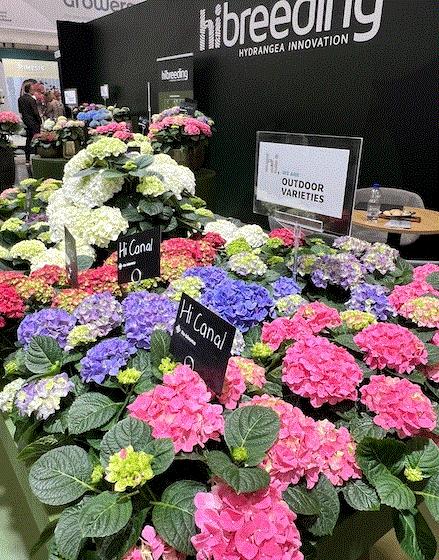
Hi Breeding at IPM 2024.
Creekside has been producing dormant hydrangeas for Perlanova, HI and other breeders for the North American market for a number of years. During the last few years, URCs of HI Hydrangeas have been available from Creekside through Syngenta. Since Ontario provides an ideal climate for stock production of hydrangeas, Creekside can provide them as URCs, which will now be sold exclusively through Express.
The exclusive access to the HI Hydrangea program may be new to Express, but working with Creekside isn’t anything new for either business.
“Creekside was a strategic supplier for us and did a great job in hydrangeas,” explained Rebecca Siemonsma, Director of the InBlume program. “We had also invested a lot in selling hydrangeas and had a great relationship with that team. So when they were looking for a new strategic partner in the U.S., it made perfect sense.”
“We were already selling 90% to 95% of the dormants coming out of Creekside,” said Scott Valentine, CEO for Express. “We knew the dynamics in the marketplace, so it was just a natural fit to evolve the partnership.”
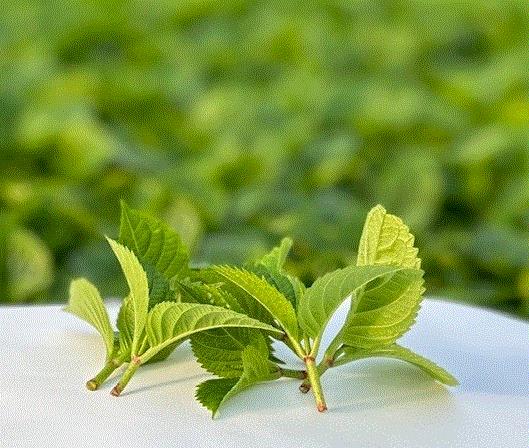
Although the HI Hydrangea line is primarily made up of potted varieties, the goal is to expand the breeding program to not only include the indoor flowering plants market, but also outdoor patio, landscape and cut flower markets, as well.
“All four partners are now going to work together on innovating in the category and targeting those segments,” said Scott Rusch, Business Development Director for Express. “And then as Express with our InBlume and InFlora initiatives, vetting these varieties and recommending the best hydrangea for each one of those customer groups.”
Express is hoping that with the partnership with the two breeders and the main supplier, they can grow the category. Potted hydrangeas have always been considered gift plants for Easter and Mother’s Day. Rebecca said that HI and Perlanova have been working on earlier-flowering varieties that can be grown for Valentine’s Day, and even Christmas. They’re not thinking of pushing potted hydrangeas for year-round production, but definitely expanding the selling window and garnering more interest as new colors are introduced.
“Especially in cut flowers, the novelty types are important,” Rebecca said. “People are looking for more than the old standard blue and pink varieties; they want something unique and different. Just like they do in all segments of our industry.”
Express will have a display for the first time at California Spring Trials—which will include the HI Hydrangea line that’s part of the InBlume program, along with their InFlora cut flower collection—at Headstart Nursery in Gilroy March 20-23.

Plants from IPM
I promised more from my visit to the big IPM trade show in Essen, Germany, and here it is: plants! Now, there are millions of individual plants and thousands of cultivars, I’m sure. So why do I show you just six? Because the vast majority are either 1) not new or b) not available here or III) I have no clue if they are new or available. So I report what catches my eye and what I think you can buy or create yourself.
Oh, before I get into those, HERE IS A LINK to a long video I shot from the show! It covers technology, trends, new plants (including the ones below), and more, all while showing you what the show looks and feels like.
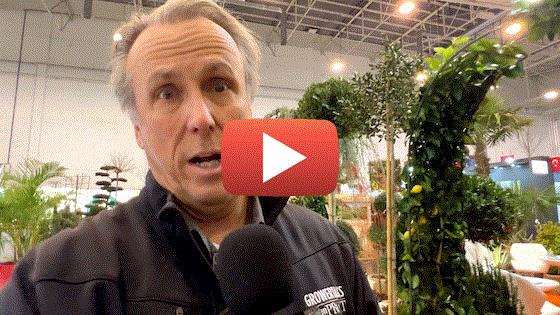
Now on to some plants:
Bloom’Z Natural Happiness Bouquet. From Hortinno of Belgium, this is an indoor potted azalea featuring three colors of flowers in one pot. The printed sleeve brags that it will give you 50 days of color in the home.
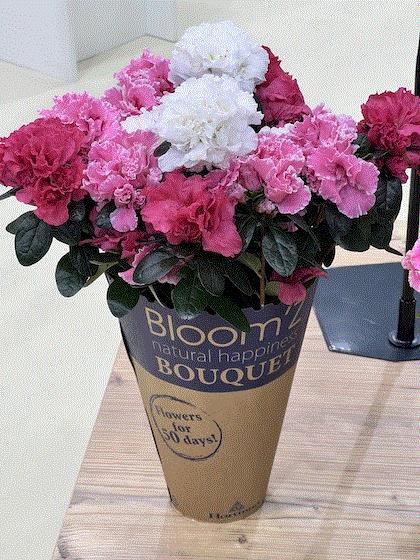
ZZ Chameleon. This Zamioculcas was found and patented by famed plant-hunter Mike Rimland and offered in Europe by Ornamentex. It’s available here via Costa Farms, which has been selling it for 18 months (see, sometimes WE lead the way!). Mike explained that the new foliage lacks chlorophyll, giving it the bright yellow color. Once the leaves start to mature they turn green.
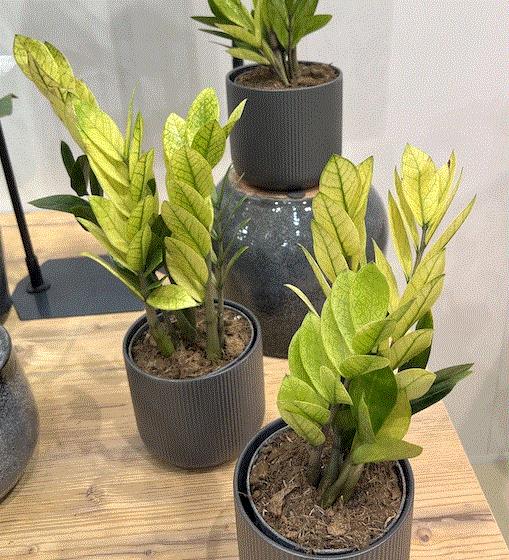
Tradescantia Pink Paradise, bred by Gartneriet Lundager of Denmark. And also Peperomia Cayenne. Both of these were in the novelty competition at IPM (as were the two above, for that matter). I like the peperomia, but I REALLY like the tradescantia, and I hope somebody makes it available in North America. The violet color is striking against the rich, sparkly silver. It’s as pretty a wandering Jew (or wandering dude, if you prefer) as I’ve ever seen.
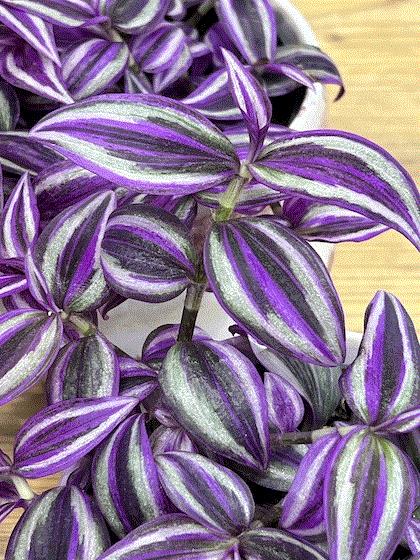
I saved what I think is the best for last: Fantasy Star poinsettia from Selecta One. A sport of Sky Star, Fantasy Star eliminates the need to paint or glitter your poinsettias!
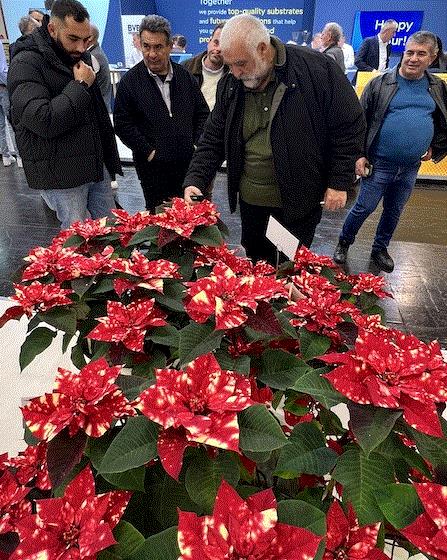
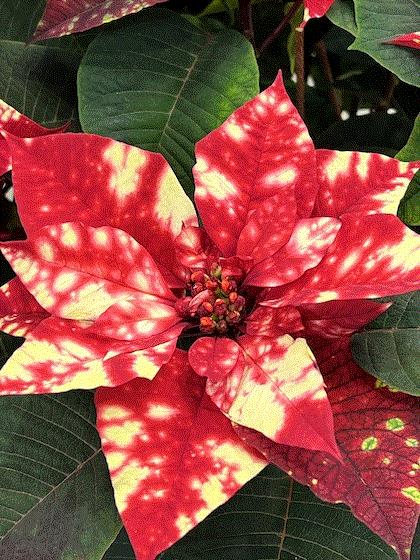
Look at that wild pattern, and the red cyathia and red stems. For the best white, finish cool, they say. Fantasy Star will be trialed in North America this season and available commercially for 2025. (Note: an orange version is coming, too!)

More on poinsettias
Before I started traveling, I was asking about your experiences with poinsettias in 2023. Here’s one more reply:
Illinois (7). Customer base: Wholesale/Costco. “Sales were fine, not good, not great. We are selling a 26-in. poinsettia for $15.99—a deal that you cannot get anywhere else. Season after season it feels that poinsettia sales have flatlined, if not declined.”—Lizi Leider, Leider Greenhouses
I agree, Lizi—Costco offers the best deal on poinsettias (and other plants) that consumers can find! (I also love their meat, seafood, wine, coffee and paper products.)
Academics weigh in on poinsettias
Remember when Ellen Egan of Egan Gardens wrote about her views on poinsettias? She said, in part, “The energy used for heating a sub-tropical crop in some of the coldest months of the year and the extra plastics of pot rings and sleeves that my other crops don’t need, all for plants that will be discarded four to six weeks after delivery, strikes me as insane. Why are large numbers of poinsettias being produced for mass merchandisers to sell cheap? Are there other, less wasteful, ways to keep a crew working through the winter? Other lower-input crops to help carry the overhead through those months?”
I shared her thoughts and asked you if you agreed or disagreed or had another viewpoint. Two of you responded, both academics, one from Rutgers and one from Des Moines Area Community College (one of America’s top-rated two-year academic institutions). Here’s what they had to say:
“I agree with Ellen. It is a waste of energy and supplies. I don’t buy them anymore because I don’t like throwing plants out. My wife and kids would look at me like I’m crazy for keeping a poinsettia all year long in our family room only to produce a leggy, partially finished, plant by the next holiday. We see that few people in the U.S. recycle. Look into any garbage container on a campus, mall or public place and see recyclable cans and bottles in the garbage. Many times, there is a recycling can right next to the garbage can. Now, think of all the poinsettias being discarded, instead of having the plant composted and the pot recycled. Living a sustainable life has to start somewhere. Our industry can lead the way.”—Joe Florentine, MS, Associate Director, NJAES, Rutgers University, Cook Campus
“I’d like to propose a question that I don’t have an answer to that Ellen starts to reference. Big box stores are here to stay, so the question is: How do we get horticulture product to be valued more highly and moved at more reasonable prices, especially at box stores? NFL commercials? Lessons in K-12 school? Since box stores will not be going away anytime soon, how do we make it work so that industry retailers maintain profits and box stores have a quality selection of affordable plants that don’t look like death due to neglect? How do we get horticulture to infiltrate the box store system, or what agreement can we make to get box stores to stop selling plants? I think we’d all be okay with them selling hardgoods.”—Christina Riessen, Horticulture Instructor, Des Moines Area Community College
All valid points, Joe and Christina. Thanks for weighing in!
Any thoughts on what they had to say? Are they more sustainable than it looks on the surface? (I mean, they do make oxygen while growing …). And maybe box stores are more successful with poinsettias than those of us on the outside think? Send your thoughts to me at beytes@growertalks.com.

Finally …
Is this the oldest Venlo greenhouse in Venlo?
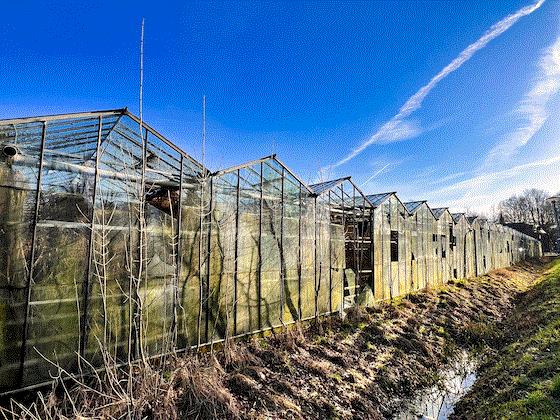
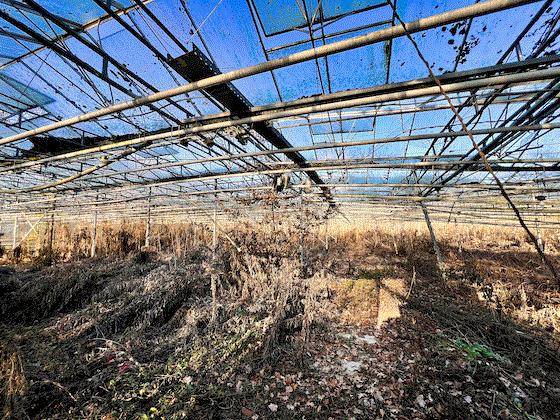
Located on the corner of Genooyerweg and Genooyerkapelweg in the Dutch border town of Venlo, the vintage greenhouse is right next to the famous kapel of Genuuje, which dates from 1631 ... a bit earlier than this interesting landmark.
This photo started as a lark as I was driving from Essen, Germany, back to Amsterdam for my flight home. Venlo is just a short detour, and there's a fabulous garden center nearby (Tuincentrum Leurs). I thought I'd just drive the back roads, letting my GPS keep me from getting completely lost, and see if I could find a really old, really vintage Venlo greenhouse. Maybe the oldest in town!
Why? Because Venlo has given its name to a style of greenhouse featuring multiple ridge-and-furrow roof sections over wide bays. Roof vents provide air flow. The design allows for single panes of glass with no leaky lap joints. As I understand it, the idea was maximum light, wide bays with fewer columns, and energy efficiency.
Alas, I know nothing of who designed the first Venlo greenhouse, or why the design became so universally accepted—and so timeless! The main difference between this house and a new one is the gutter height and glass pane size. Some new glass, a weeding, and probably some electrical and plumbing work and it could be growing plants again.
I'd love to know more about Venlo houses, and this one in particular. Any Dutch readers able to fill us in? Do so at beytes@growertalks.com.









Feel free to email me at beytes@growertalks.com if you have ideas, comments or questions.
See you next time!

Chris Beytes
Editor-in-Chief
GrowerTalks and Green Profit
This e-mail received by 27,293 loyal readers!
Thanks to my loyal sponsors, who help me reach the 27,293 readers of Acres Online in more than 60 countries. Want to be one of them (a sponsor, that is)? Give Kim Brown a shout and she will tell you about our many advertising opportunities.